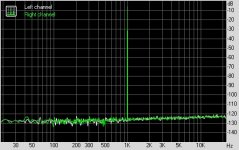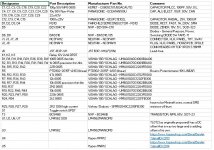I got my build ready but it does not work properly. I have DC offset that goes up when the pot goes louder.
I did not have small enough 10uF foils and i do not have ceramics ( what where they original ? ) so i made some bipolars from two antiparallel Silmics.
Could that be the problem ?
I did not have small enough 10uF foils and i do not have ceramics ( what where they original ? ) so i made some bipolars from two antiparallel Silmics.
Could that be the problem ?
Mea Culpa, i have it working. I forgot one resistor in the Servo and wired the Pot wrong.
Out of no other reason then routine i grounded one side, stupid.
Bandwidth is 2MHz ( -3dB ) with a slight overshot.
I see the problem with the pot.
When i fully crank it the sine looks like a square. That is the infinite gain problem.
Out of no other reason then routine i grounded one side, stupid.
Bandwidth is 2MHz ( -3dB ) with a slight overshot.
I see the problem with the pot.
When i fully crank it the sine looks like a square. That is the infinite gain problem.
There is a very nice alternative for the potmeter developed by Hans Polak here: Downloads | Linear Audio.
Haven't tried it myself yet though.
Jan
Haven't tried it myself yet though.
Jan
I already started to make a board of this preamp to my own requirements, but then I gave up, because of the problem with the volume pot.
Now I will carry on with that.
May I ask which amendments to the configuration that Bruno had proposed you are going to make, and why? I am currently organising a group buy for both 'bare' PCBs and completely built modules, so maybe you would want to join if you could go with the existing PCB layout.
Thanks,
Robert
*
I have still the original board which came with the Linear Audio lying around somewhere (@ billshurv: you found one of the 1000 lingering in drawers
*
Putzeys excellent article (along with some others (Whitlock)) convinced me to try to switch everything in my chain to balanced (bit by bit).
I thought that when I design the board more flexible, I could for example swap the volume-control-stage to an a RIAA stage.
Making my own pcb gives me also more freedom with the selection of the parts. A balanced design could benefit for example from the use X2Y caps and resistors-arrays with 0.05% matching (which are not that expensive anymore).
*
Regards, Boris
I have still the original board which came with the Linear Audio lying around somewhere (@ billshurv: you found one of the 1000 lingering in drawers
*
Putzeys excellent article (along with some others (Whitlock)) convinced me to try to switch everything in my chain to balanced (bit by bit).
I thought that when I design the board more flexible, I could for example swap the volume-control-stage to an a RIAA stage.
Making my own pcb gives me also more freedom with the selection of the parts. A balanced design could benefit for example from the use X2Y caps and resistors-arrays with 0.05% matching (which are not that expensive anymore).
*
Regards, Boris
Okay, inserting the filter as a „black box with input, output and ground” is one possibility.
Bruno states in his article, that any filter could be swapped to balanced by “flipping the feedback network over”, ie creating a second network, which is mirror-inverted connected to the other input of the opamp.
Here is a more precise explanation: The G word: How to get your audio off the ground (Part 2) | EDN
Bruno states in his article, that any filter could be swapped to balanced by “flipping the feedback network over”, ie creating a second network, which is mirror-inverted connected to the other input of the opamp.
Here is a more precise explanation: The G word: How to get your audio off the ground (Part 2) | EDN
In case you haven't seen this yet: both Bruno and Jan had pointed out that Bruno's design 'in real life' offers excellent measured performance.
Hans Polak in his article 'An alternative Volume Controller for the Bruno Putzeys balanced Pre Amp' in Linear Audio shows the output spectrum of a 1kHz 1V signal in 0dB gain mode:

This measured unit by the way was built with Hans' alternative voltage controller PCB as featured in his article, so I consider my former concerns that it could have an effect on performance of the original design to be pretty pointless.
Many thanks to Hans and Jan!
Robert
Hans Polak in his article 'An alternative Volume Controller for the Bruno Putzeys balanced Pre Amp' in Linear Audio shows the output spectrum of a 1kHz 1V signal in 0dB gain mode:

This measured unit by the way was built with Hans' alternative voltage controller PCB as featured in his article, so I consider my former concerns that it could have an effect on performance of the original design to be pretty pointless.
Many thanks to Hans and Jan!
Robert
I love the idea behind this and will give it a go at some point.
One thing I would like to do though is have more than 2 stereo inputs. Having to switch with two is easy with the relays, but if I wanted, say, 4 or 5 (all balanced of course), which approach would you recommend keeping the design as clean and neutral as possible? Big rotary selectors? Some multiplexing / switching IC?
One thing I would like to do though is have more than 2 stereo inputs. Having to switch with two is easy with the relays, but if I wanted, say, 4 or 5 (all balanced of course), which approach would you recommend keeping the design as clean and neutral as possible? Big rotary selectors? Some multiplexing / switching IC?
I would use a small relay board attached to the back panel over the input sockets.
This would keep the loop areas of the inputs lowish and with careful use of twisted pairs becomes very low and tolerant of interference.
The relays can be controlled with a cheap rotary switch, single pole multiway. You can get upto 11W, or use a 6W 2p and use the extra pole to light indicator LEDs.
The relays can also be controlled with digital via push buttons. Too complicated for me!
This would keep the loop areas of the inputs lowish and with careful use of twisted pairs becomes very low and tolerant of interference.
The relays can be controlled with a cheap rotary switch, single pole multiway. You can get upto 11W, or use a 6W 2p and use the extra pole to light indicator LEDs.
The relays can also be controlled with digital via push buttons. Too complicated for me!
BoM
Gents, can I please ask for your help:
In order to get the Group Buy going, I need to finalise the BoM and get the appropriate parts. From various recommendations, including Paul Hendriks' BOM which is available for Download on Linear Audio here, and Hans Polak's, I have put together the following BoM:
In MS Word DOC format (MS Excel XLS won't work as attachment): View attachment BP v5 fb28 BoM.doc
As picture in JPG format (in case you don't want to download and open a DOC):
For most resistors (especially those around U2/7) I have used very low temp coeff. ones in order to keep thermal distortion at a minimum. Hans had recommended to use LM4562 instead of TL072 for U3, because the latter's DC offset was way too high.
Can you please help me to make the right and best possible choices, by having a look and sending your comments, recommendations and advice?
Many thanks,
Robert
Gents, can I please ask for your help:
In order to get the Group Buy going, I need to finalise the BoM and get the appropriate parts. From various recommendations, including Paul Hendriks' BOM which is available for Download on Linear Audio here, and Hans Polak's, I have put together the following BoM:
In MS Word DOC format (MS Excel XLS won't work as attachment): View attachment BP v5 fb28 BoM.doc
As picture in JPG format (in case you don't want to download and open a DOC):

For most resistors (especially those around U2/7) I have used very low temp coeff. ones in order to keep thermal distortion at a minimum. Hans had recommended to use LM4562 instead of TL072 for U3, because the latter's DC offset was way too high.
Can you please help me to make the right and best possible choices, by having a look and sending your comments, recommendations and advice?
Many thanks,
Robert
Last edited:
- Home
- Source & Line
- Analog Line Level
- BPPBP - Bruno Putzey's Purist Balanced Preamp (well a balanced volume control really)